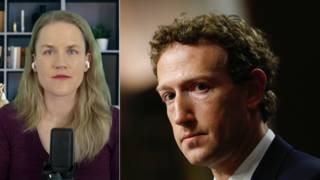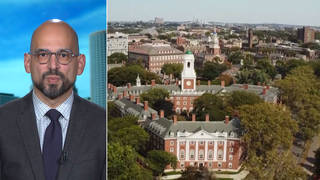
Guests
- Sandra Steingraberecologist, author and cancer survivor. She is an internationally recognized expert on the environmental links to cancer and reproductive health and the author of many books, including Living Downstream: An Ecologist Looks at Cancer and the Environment.
This week marks the 100th anniversary of the birth of Rachel Carson, the marine biologist and author credited for launching the modern environmental movement. We take a look at her life and legacy. [includes rush transcript]
Transcript
JUAN GONZALEZ: One hundred years ago this week, the marine biologist and author Rachel Carson was born. In 1962, she published the groundbreaking work Silent Spring, that helped launch the environmental movement. It was one of the most controversial books of the 1960s. Her warnings about the dangers of DDT and other chemical pesticides helped launch the environmental movement. At the time, Carson was widely attacked by the chemical industry and much of the press.
AMY GOODMAN: Time magazine claimed Carson’s research was filled with oversimplifications and downright errors. That was in 1962. Time magazine would later name Rachel Carson one of the 100 most important people of the 20th century, largely because of her book, Silent Spring. She died of cancer at the age of 56 in 1964, just two years after the book’s publication.
In a moment, the ecologist and author Sandra Steingraber will join us from Ithaca, New York, but first Rachel Carson in her own words.
RACHEL CARSON: Is industry becoming a screen through which facts must be filtered, so that the hard, uncomfortable truths are kept back and only the harmless morsels are allowed to filter through? I know that many thoughtful scientists are deeply disturbed that their organizations are becoming fronts for industry. More than one scientist has raised the question of whether a spirit of Lysenkoism may be developing in America today, the philosophy that perverted and destroyed the science of genetics in Russia and even infiltrated all of that nation’s agricultural sciences. But here, the tailoring, the screening of basic truth, is done, not to suit any party line, but to accommodate to the short-term gain, to serve the gods of profit and production.
AMY GOODMAN: Rachel Carson, courtesy of the Pacifica Radio Archives. Sandra Steingraber now joins us from Ithaca, New York, internationally recognized expert on the environmental links to cancer and reproductive health, author of a number of books, including Living Downstream: An Ecologist Looks at Cancer and the Environment. In a nutshell, if you could tell us about who Rachel Carson was, where she lived, how she wrote Silent Spring, and the effect that it had.
SANDRA STEINGRABER: Well, Rachel Carson was both a wildlife biologist and a writer. She grew up in rural Pennsylvania and was first very much influenced by her own mother. They spent a lot of mother-daughter hours together out in nature. And when she went off to college, she had a big existential decision to make about whether to study biology or English. She decided to study biology, because she felt she could learn to be a writer on her own, but she couldn’t do biology by herself.
She went off to study the ocean at Woods Hole and wrote many lyrical books about the sea, and then became radicalized by the ongoing and reckless use of pesticides as a scientist and a public servant in the U.S. Department of Fish and Wildlife, where she began to realize there was a disconnect between what scientists knew about the harmful effects of pesticides and what the public was hearing about that. And so, she chose to use her life as a writer and as a biologist to build a kind of bridge across that breach and bring out of the soundproof technical literature the evidence, the damning evidence, for the reckless use of pesticides and its effect on human health and the ecosystem and present that before the public. And she really, in doing this, saw herself — in her private writings, she wrote about herself as a kind of prosecuting attorney that was going to make her case before the public, who would be a kind of jury. And so, she really did lay before the public the scientific evidence against pesticides. And that happened in 1962.
And what the public did not know, nor did her enemies in industry know, was that she was dying of breast cancer while she was doing all this research and writing, and going through radiation treatment and chemotherapies and surgeries. And so, she died then of breast cancer within 18 months after Silent Spring was published in 1962. Her ongoing work that she wished to get to next would have investigated the interlocking structures between industry and the scientific community in ways that she believed were corrupting science. That is the work that she left undone.
JUAN GONZALEZ: And the impact of her book at the time of its publication on science and on the politics of environmental protection?
SANDRA STEINGRABER: Well, her book rocketed to the top of the best-seller list and stayed there for a long time. And it remains one of the best-selling books in science. I think it’s rivaled only by its impact maybe with Charles Darwin’s Origin of Species, which was published a hundred years earlier. And I think it’s important to understand, too, the way that environmental activism really opened up a critical space in our culture for Silent Spring to be published. A lot of people credit Rachel Carson with being kind of the mother of environmental activism, if you will, as though she made the scientific case, and then the environmental activists took it forward and made the policy changes.
But what I argue in a new essay is that there was really a more reciprocal relationship between Carson and environmental activism than we really realize. And indeed, throughout the 1950s, actually at the height of the McCarthy era, there was an environmental grassroots group in Long Island that called themselves the Committee Against Mass Poisoning, and they objected to the mass spraying of pesticides by air over residential areas and filed a lawsuit that wended its way all the way up to the Supreme Court. They also organized and wrote letters to the editor. The result was that the literary community of New York City learned a lot about this, and they offered Rachel Carson the opportunity to publish.
AMY GOODMAN: Sandra Steingraber, we want to thank you very much for being with us, ecologist and author, talking about Rachel Carson on this hundredth anniversary of her birth. Rachel Carson, author of Silent Spring.













Media Options